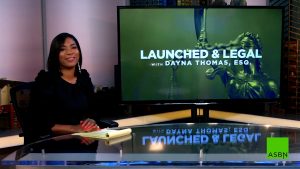Today on this week’s episode of Launched & Legal, Dayna Thomas sits down to explain the best tips and tricks to help monetize, strategize, and legalize your business. By sharing the best tips and practices on choosing a brand name for trademark protection, Thomas transitions your business to the next level.
Levels of trademark: The sliding scale
To begin, there are five levels of trademark protection to follow on a scale that depicts how likely your trademark will get accepted.
- At the bottom of the scale are generic trademarks. Generic trademarks are ineligible for protection, especially when maybe just a part of the word or phrase is generic. For example, trying to trademark “Beauty Salon” for any beauty salon services will not be accepted for any protection.
- Following is a descriptive trademark. This is when the brand name or mark describes your product or service. Even though you can qualify for these, it’s encouraged to stay clear of them since the protection won’t be as strong. For example, if you attempt to trademark “cheesy pies” for a pizza place, chances are they’re other “cheesy pies” in the area. Again the protection will be fairly weak.
|
- Then, the super sweet spot for trying to determine a brand name is harder with suggestive trademarks. As the name entails, this trademark suggests what a product or service is about. For example, “penguin” is a name for a refrigerator to suggest that it gets really cold like where penguins live. However, there is no actual connection between the name and the product being serviced.
- Second, to the top, is an arbitrary trademark. This protection is very strong, however, there is more money being spent on marketing campaigns. Since arbitrary words are real words with no actual connection to the product or service, the marketing side has to be extremely strong. For example, Apple is a real fruit. But, for trademark protection, the technology company had to push some serious campaigns to make the connection it has today.
- Finally, at the top with the strongest and broadest protection is a fanciful trademark. This type of trademark is the most challenging since these are made-up words. For example, Kodak was marketed to connect to photography which led consumers to buy cameras and film. Another example is Google, a made-up word that has taken the trademark strategy by storm to be what it is today.
Overall, the more your name has nothing to do with your product or service, the more likely your trademark application will get accepted. Therefore, don’t use generic words, stay away from descriptive and suggestive words, and be prepared to spend marketing dollars with arbitrary and fanciful trademarks.
The Atlanta Small Business Network, from start-up to success, we are your go-to resource for small business news, expert advice, information, and event coverage.
While you’re here, don’t forget to subscribe to our email newsletter for all the latest business news know-how from Atlanta Small Business Network.



 More:
More: 
